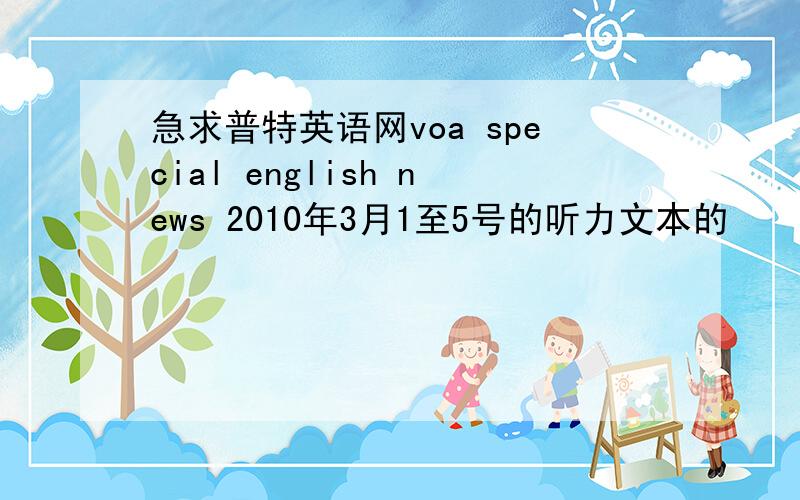急求普特英语网voa special english news 2010年3月1至5号的听力文本的
来源:学生作业帮 编辑:神马作文网作业帮 分类:英语作业 时间:2024/11/19 19:00:04
急求普特英语网voa special english news 2010年3月1至5号的听力文本的
急求听力文本,普特英语网的voa special english news 2010年3月1至5日的
急求听力文本,普特英语网的voa special english news 2010年3月1至5日的

0301
This is the VOA Special English Development Report.
We talked last week about counterfeit medicines and how the problem is especially bad in Africa,Asia and Latin America.The World Health Organization says up to thirty percent of the medicine sold in many developing countries is not real.
It also estimates that up to fifty percent of the medicine sold on the Internet is counterfeit.That can put people at risk even in wealthy countries that represent only a small part of the counterfeit drug market.
Today we look at what is being done to fight counterfeit drugs.
Several companies are developing ways to make counterfeits easier to identify.And there are existing methods,like a machine that can quickly identify chemicals in pills to confirm if the pills are real.
Other ideas include things like special tracking codes for drug packages.People could send a text message with the code and get a message back confirming that what they bought is listed in a database.
Some drug makers and other companies put three-dimensional images called holograms on their products as a security device.
Other anti-counterfeit efforts include the use of radio frequency identification tags.Many companies use these electronic tags to follow products through the supply chain from the manufacturer.The American Food and Drug Administration says R.F.I.D.tags act like an electronic safety net to make it easier to catch counterfeits.
Last July,the Food and Drug Administration advised manufacturers to add what are called physical chemical identifiers to their medicines.These are special chemicals,colorings or tastes that counterfeiters could not easily copy.
Bryan Liang is with the Partnership for Safe Medicines,an organization in the United States.He says the Internet is not only a place where people can get tricked into buying counterfeit drugs.It is also a place where counterfeiters can find all the materials they need to make them.
BRYAN LIANG:"The Internet is the Wild,Wild West.Anybody can sell drugs.Anybody can buy active ingredients."
He says the most important members of the "counterfeit detection team" are the patients themselves.He says raids on counterfeiters are often the result of information from people who bought fake medicines.
BRYAN LIANG:"The best approach is to know your drug.Know what they feel like.Know what they taste like.Know what your traditional reactions are.A person that knows their drugs and the effects of their drugs are in fact the best security against fakes."
And that's the VOA Special English Development Report,written by June Simms.You can find last week's report on counterfeit drugs at voaspecialenglish.com.I'm Steve Ember.
This is the VOA Special English Development Report.
We talked last week about counterfeit medicines and how the problem is especially bad in Africa,Asia and Latin America.The World Health Organization says up to thirty percent of the medicine sold in many developing countries is not real.
It also estimates that up to fifty percent of the medicine sold on the Internet is counterfeit.That can put people at risk even in wealthy countries that represent only a small part of the counterfeit drug market.
Today we look at what is being done to fight counterfeit drugs.
Several companies are developing ways to make counterfeits easier to identify.And there are existing methods,like a machine that can quickly identify chemicals in pills to confirm if the pills are real.
Other ideas include things like special tracking codes for drug packages.People could send a text message with the code and get a message back confirming that what they bought is listed in a database.
Some drug makers and other companies put three-dimensional images called holograms on their products as a security device.
Other anti-counterfeit efforts include the use of radio frequency identification tags.Many companies use these electronic tags to follow products through the supply chain from the manufacturer.The American Food and Drug Administration says R.F.I.D.tags act like an electronic safety net to make it easier to catch counterfeits.
Last July,the Food and Drug Administration advised manufacturers to add what are called physical chemical identifiers to their medicines.These are special chemicals,colorings or tastes that counterfeiters could not easily copy.
Bryan Liang is with the Partnership for Safe Medicines,an organization in the United States.He says the Internet is not only a place where people can get tricked into buying counterfeit drugs.It is also a place where counterfeiters can find all the materials they need to make them.
BRYAN LIANG:"The Internet is the Wild,Wild West.Anybody can sell drugs.Anybody can buy active ingredients."
He says the most important members of the "counterfeit detection team" are the patients themselves.He says raids on counterfeiters are often the result of information from people who bought fake medicines.
BRYAN LIANG:"The best approach is to know your drug.Know what they feel like.Know what they taste like.Know what your traditional reactions are.A person that knows their drugs and the effects of their drugs are in fact the best security against fakes."
And that's the VOA Special English Development Report,written by June Simms.You can find last week's report on counterfeit drugs at voaspecialenglish.com.I'm Steve Ember.
急求普特英语网voa special english news 2010年3月1至5号的听力文本的
voa special English news的文本怎么找
哪里有VOA special english 的world news 的文本,急!
普特的每日听力,VOA Special English栏目中1530、report、feature是什么意思?整点新闻吗
VOA Special English、VOA Standard English到底是指的那个台:VOA News No
跪求 VOA special English - WORLD NEWS - April 18th, 2012 的英文字幕
求VOA的SPECIAL ENGLISH的原文
怎么使普特网的VOA听力速度变慢
跪求2011年11月13日的VOA News Headlines和BBC World News的听力原稿~
VOA special English比英语四级的听力难吗?
求2009年2月18日的voa special English 每日新闻的原文(所有,越快越好)
急求听力原文,This is the VOA special English economics report.This